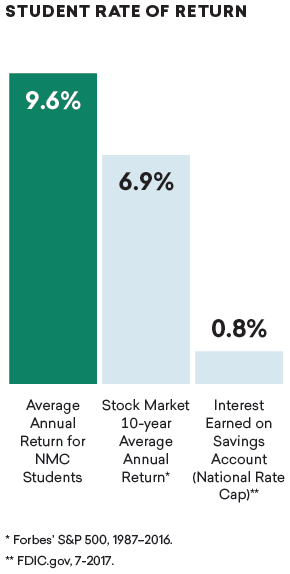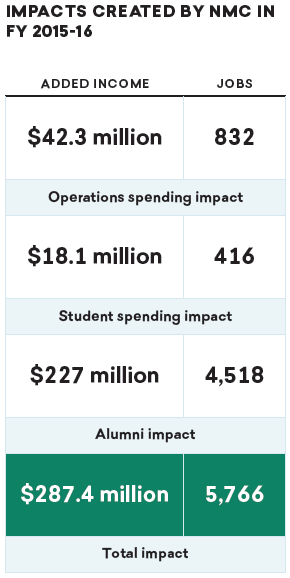|
NMC creates a significant positive impact on the business community and generates a return on investment to its major stakeholder groups — students, taxpayers and society — according to a 2017 study by the economic modeling firm Emsi. Using a two-pronged approach that involves an economic impact analysis and an investment analysis, the study calculates the benefits received by each of these groups. Results of the analysis reflect fiscal year (FY) 2015-16. |
 Return On Investment To Students, Taxpayers, And Society
Return On Investment To Students, Taxpayers, And Society
Student perspective
- NMC’s FY 2015-16 students paid a total present value of $25 million to cover the cost of tuition, fees, supplies, and interest on student loans. They also gave up $57.7 million in potential earnings had they been working instead of learning.
- In return for the monies invested in the college, students will receive a present value of $165.9 million in increased earnings over their working lives. This translates to a return of $2.00 in higher future earnings for every $1 that students invest in their education. The average annual return for students is 9.6%.
Taxpayer perspective
- In FY 2015-16, state and local taxpayers in Michigan paid $23.8 million to support the operations of NMC. The net present value of the added tax revenue stemming from the students’ higher lifetime earnings and the increased output of businesses amounts to $61.1 million in benefits to taxpayers. Savings to the public sector add another $8.9 million in benefits due to a reduced demand for government-funded services in Michigan.
- Dividing benefits to taxpayers by the associated costs yields a 2.9 benefit-cost ratio, i.e., every $1 in costs returns $2.90 in benefits. The average annual return on investment for taxpayers is 10.5%.
Social perspective
- The economic base in Michigan will grow by $651.7 million over the course of the students’ working lives. Society will also benefit from $37.5 million in present value social savings related to reduced crime, lower unemployment, and increased health and well-being across the state.
- For every dollar that society spent on NMC FY 2015-16 educations, society will receive a cumulative value of $5.40 in benefits, for as long as the FY 2015-16 student population at NMC remains active in the state workforce.
 Impact On The Business Community
Impact On The Business Community
During the analysis year, NMC and its students added $287.4 million in income to the NMC Service Area economy, approximately equal to 3.6% of the region’s total gross regional product (GRP). By comparison, this impact from the college is nearly as large as the entire Wholesale Trade industry in the region. The economic impacts of NMC break down as follows:
Operations spending impact
- NMC employed 709 full-time and part-time employees in FY 2015-16. Payroll amounted to $34.9 million, much of which was spent in the NMC Service Area to purchase groceries, clothing, and other household goods and services. The college spent another $26.1 million to support its day-to-day operations.
- The net impact of college payroll and expenses in the NMC Service Area during the analysis year was approximately $42.3 million in income.
Student spending impact
- Around 48% of students attending NMC originated from outside the region. Some of these students relocated to the NMC Service Area. In addition, a number of students would have left the region if not for NMC. These relocated and retained students spent money on groceries, transportation, rent, and so on at regional businesses.
- The expenditures of relocated and retained students during the analysis year added approximately $18.1 million in income to the NMC Service Area economy.
Alumni impact
- Over the years, students have studied at NMC and entered or re-entered the workforce with newly-acquired skills. Today, thousands of these former students are employed in the NMC Service Area.
- The accumulated contribution of former students currently employed in the regional workforce amounted to $227 million in added income during the analysis year.